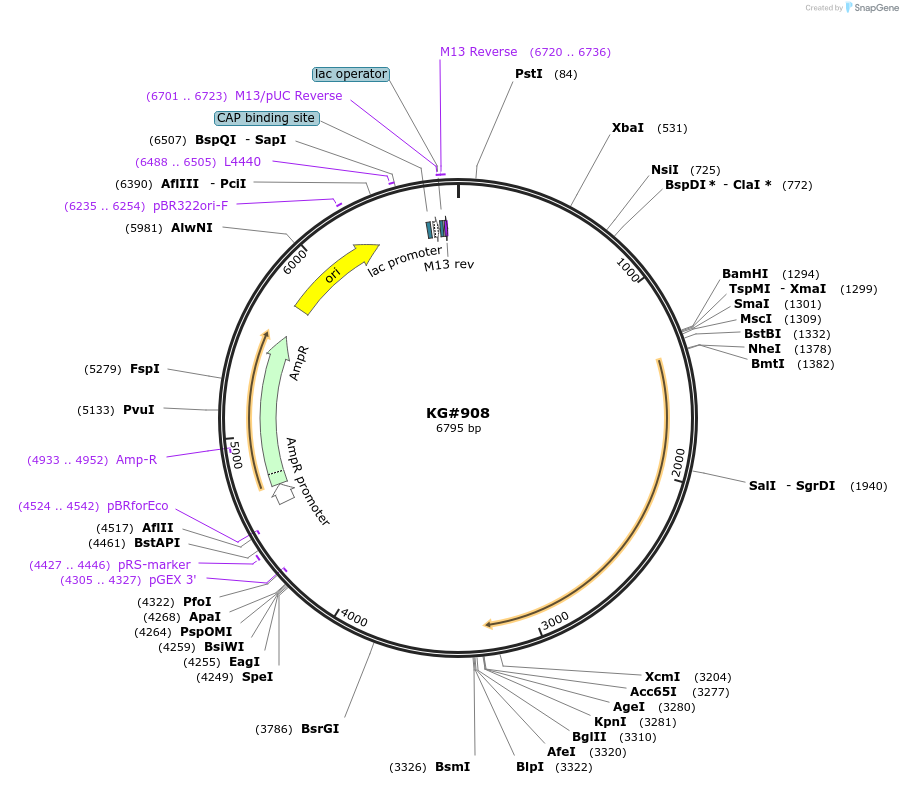KG#908
(Plasmid
#110914)
-
PurposeExpresses the plant proteins TIR1 (necessary for Auxin-Inducible Degradation) pan-neuronally in C. elegans
-
Depositing Lab
-
Sequence Information
Ordering
| Item | Catalog # | Description | Quantity | Price (USD) | |
|---|---|---|---|---|---|
| Plasmid | 110914 | Standard format: Plasmid sent in bacteria as agar stab | 1 | $85 | |
Backbone
-
Vector backbonepUC
-
Vector typeBacterial Expression
Growth in Bacteria
-
Bacterial Resistance(s)Ampicillin, 100 μg/mL
-
Growth Temperature37°C
-
Growth Strain(s)DH5alpha
-
Copy numberHigh Copy
Gene/Insert 1
-
Gene/Insert namerab-3 promoter
-
SpeciesC. elegans (nematode)
-
Insert Size (bp)1208
Cloning Information for Gene/Insert 1
- Cloning method Unknown
- 5′ sequencing primer Unknown (Common Sequencing Primers)
Gene/Insert 2
-
Gene/Insert nameTIR1 cDNA
-
SpeciesA. thaliana (mustard weed)
-
Insert Size (bp)1887
Cloning Information for Gene/Insert 2
- Cloning method Unknown
- 5′ sequencing primer Unknown (Common Sequencing Primers)
Gene/Insert 3
-
Gene/Insert nameunc-54 3' control region with 1 artificial intron just upstream and 1 artificial intron in control region
-
SpeciesC. elegans (nematode)
-
Insert Size (bp)996
Cloning Information for Gene/Insert 3
- Cloning method Unknown
- 5′ sequencing primer Unknown (Common Sequencing Primers)
Resource Information
-
Supplemental Documents
Terms and Licenses
-
Academic/Nonprofit Terms
-
Industry Terms
- Not Available to Industry
Trademarks:
- Zeocin® is an InvivoGen trademark.
Depositor Comments
We used Q5 polymerase and primers engineered with restriction sites to amplify the 1885 bp TIR1 sequence from pLZ31 and cloned it into Nhe I/ Kpn I cut KG#59 (4.9 Kb). Transformed into XL1-Blue electrocompetent cells. Did Qiagen preps on 2 clones to find one with correct size insert for sequence verification.
Features of the construct: The rab-3:: promoter drives expression pan-neuronally. AAAA provides a consensus ribosome binding site. TAA AT provides a consensus stop translation site. This is the Arabidopsis thaliana (mustard weed) TIR1 sequence published in the Zhang et al., 2015 Auxin Inducible Degradation paper from the Dernburg lab. It has been codon optimized for C. elegans and contains 2 synthetic introns to boost expression. It also contains 2 point mutations (D170E and M473L) shown to increase the affinity of the Arabidopsis TIR1 protein for its substrates and to increase auxin sensitivity without causing auxin-independent activity. There are also introns in the 5' and 3' UTR in this vector.
These plasmids were created by your colleagues. Please acknowledge the Principal Investigator, cite the article in which the plasmids were described, and include Addgene in the Materials and Methods of your future publications.
-
For your Materials & Methods section:
KG#908 was a gift from Kenneth Miller (Addgene plasmid # 110914 ; http://n2t.net/addgene:110914 ; RRID:Addgene_110914)


